Mark Twain wasn’t joking when he griped that Southerners’ obsession with the chivalric novels of Sir Walter Scott helped cause the Civil War. In Life on the Mississippi, he laments that Scott had “run the people mad, a couple generations ago, with his medieval romances,” inspiring “maudlin Middle-Age romanticism here in the midst of the plainest and sturdiest and infinitely greatest and worthiest of all the centuries the world had seen”:
The South has not yet recovered from the debilitating influence of his books. Admiration of his fantastic heroes and their grotesque “chivalry” doings and romantic juvenilities still survives here, in an atmosphere in which is already perceptible the wholesome and practical nineteenth-century smell of cotton-factories and locomotives; and traces of its inflated language and other windy humbuggeries survive along with it.
I kept Twain in mind last week when I visited Antietam National Battlefield, the site of the single bloodiest day in American history: September 17, 1862, when Union and Confederate armies clashed, taking 23,000 casualties between them. The rangers at Antietam give thorough and informative talks, and I visited some of the famous sites with all due solemnity—but then I stumbled onto medievalism in the cemetery just to the south.
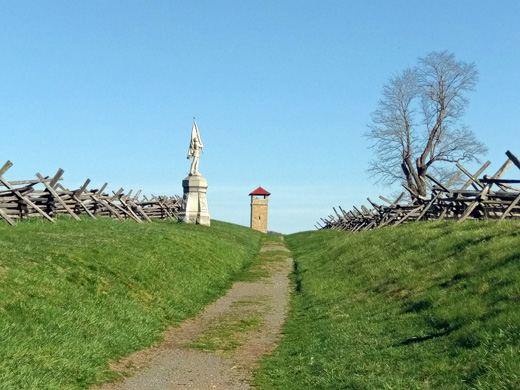
According to architectural historian Catherine Zipf, the job of designing and beautifying Civil War cemeteries fell to Montgomery Meigs, Quartermaster General of the U.S. Army during and after the war. Every cemetery was to have a superintendent’s lodge, and Meigs standardized the design: each lodge was located near the gate or the edge of the cemetery, shaped like an L with a porch and reception hall, and built in a scaled-down French Second Empire style. Here’s a good example from Glendale National Cemetery in Richmond, Virginia:
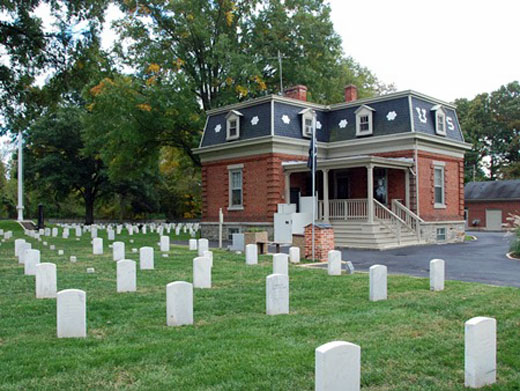
(Glendale National Cemetery, Richmond; photo from the U.S. Department of Veterans Affairs website)
After 1865, the Second Empire style was popular for federal architecture, most notably in the then-new State, War, and Navy Building next to the White House. Zipf argues that the style screamed modernity and federal control, especially when the government dropped these lodges into Southern cemeteries, where they contrasted starkly with the Greek-revival porticoes of big plantation houses. The Confederate dead were usually excluded from these cemeteries, and the huge “U.S.” on the second stories of the lodges was not subtle. Meigs let no questions linger about which side had won, and what that meant for the conquered.
So then why does the lodge at Antietam look like this?
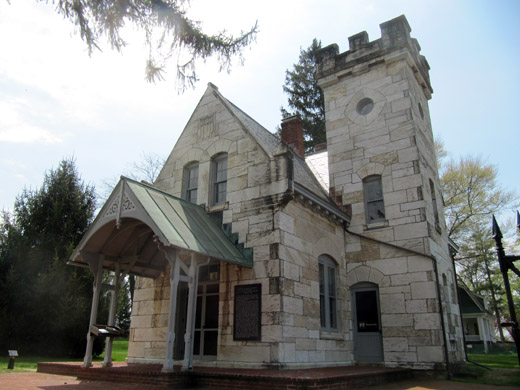
What an odd, dreamlike blending of castle and house. According to a memo on this lodge by the National Park Service’s Historic American Buildings Survey, the federal government ran 80 national cemeteries by 1880, but Antietam was one of only two originally established and run by a state. Maryland got the jump on things by convening its own cemetery commission, sending the Confederate dead to be buried elsewhere, and hiring versatile D.C.-based architect Paul Pelz to design and build this lodge in 1867. The Park Service helpfully points out its distinctive features: “stone walls, turret tower with battlements, pointed arch windows, and a gable porch with crossbracing vergeboards.” (The latter term was new to me.) The tower gave veterans and visiting mourners a view of the battlefield, but this little castle didn’t earn fealty from locals. According to the Park Service, ne’er-do-wells loitered in the cemetery, incurring the wrath of superintendents who demanded that they stop using the grounds (in the words of an 1881 War Department inspector) “as a lounging place for the floating part of the citizens, canal men, loafers, young fellows and their sweethearts.”
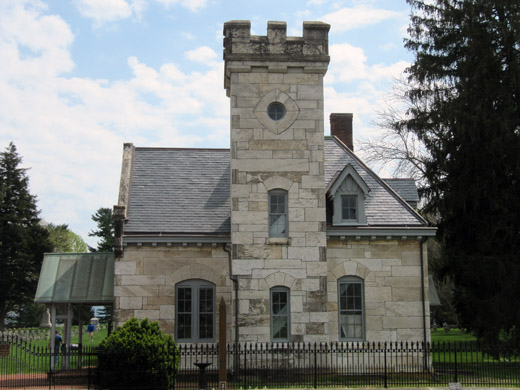
So why is the lodge at Antietam so unlike its counterparts in other federal cemeteries? American medievalism surged in the 1870s. Tourism to Europe had never been higher; at Harvard, Henry Adams became the country’s first professor of medieval history; other campuses would soon start hiring medievalists and building in neo-medieval styles; and New Yorkers were drawing up plans for the Cathedral of St. John the Divine. I suppose it’s possible that the Maryland cemetery commission chose a versatile architect simply because they wanted a trendy building.
Yet I think something bigger is going on here. Maybe this little castle reflects Maryland’s ambivalence as a slave state that stayed in the Union, neither northern nor southern in its economic mainstays or social sympathies. That’s one way to explain why a cemetery that excludes the Confederate dead would evoke the chivalry that drove wealthy Southerners to war. Maybe some Marylanders hoped to pry medievalism out of Southern hands by claiming the symbolism as a spoil of war, quashing its power by making it fully American. Maybe the house-and-tower design says that domestic tranquility is buttressed by military defense. All those things may be so—but the most likely explanation is that the lodge at Antietam is a reaction to horror, a fearful attempt to push the bloodiest day in American history—in 1867, still a fresh wound—back into a romanticized past, making it romantic, heroic, less awful to face.
If that’s the case, then the builders deceived themselves. The first federal superintendent, Civil War veteran George A. Haverfield, assumed his post here in 1879, but a War Department letter unearthed by the Park Service suggests that an unorthodox but presumably generous gesture brought down swift violence upon the house:
Haverfield, having no family with him, had his laborer and the laborer’s wife live in the lodge, and boarded with him. The husband got jealous of the Superintendent, and rather, reversing the usual order in such cases, the husband was shot dead by the accused wife. It was through this sad occurrence that I learned that Haverfield was not living with his family. Had he been, the tragedy would probably not have happened.
(letter from Captain A.F. Rockwell to Quartermaster General, 20 August 1879, cited in the Historic American Buildings Survey report on the lodge)
A graveyard castle, a love triangle, jealousy, murder—the story has all the makings of a lurid Gothic novel, and the longtime closure of the tower gives the lodge a further tinge of mystery. Twain, of course, would have shaken his head. If the architects of the Antietam lodge thought they could romanticize the battlefield, softening the carnage through the heroic haze of knightly combat, then they misunderstood the limits of medievalism. You can’t plaster over the horrors of war; the blood finds a way to seep out in the end.
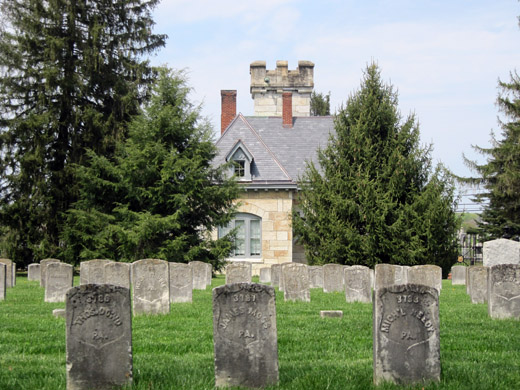

There is a small Civil War cemetery near Georgia Avenue and Piney Branch Road NW; I have been past it many time, but cannot now remember whether it had one of Meigs’s lodges in it; I incline to think that it did. The dead buried there fell at Fort Stevens, standing off Early’s raid.
What did Scott write about medieval days, other than Ivanhoe? In my spotty reading of him the center of gravity seems to be nearer 1710 than 1200. I suppose that one could argue that the Middle Ages persisted quite a while in the Highlands.
Have you written about the Scott Building at Soldiers’ Home? My WPA guide tells me the name, but not why the corners of the tower are not all the same.
LikeLike
Thanks for stopping by, George!
I just took a look using Google Street View, and indeed, the soldiers’ cemetery on Georgia Avenue north of the Walmart, Battleground National Cemetery, does indeed have one of Meigs’s little L-shaped lodges. I’ve driven that road countless times but apparently never noticed it. Good find.
The Scott building is new to me. I just looked at some photos, and it’s comparable to other buildings with clock towers from the late 19th and early 20th centuries. If the federal government ever added it to its Historic American Buildings Survey, there might be something about the architect’s intentions in their files. I’ll take a look. It’s a style I have a hard time seeing as a full-on species of “Gothic,” but people in the 19th century probably saw it as such—a distinction that’s worth a blog post in itself.
As for Sir Walter, in addition to his various long medieval-themed poems, his Waverly series included nearly 30 novels set between the 11th to the 18th centuries, with maybe a third of them set in the Middle Ages. Scott was a gigantic influence on antebellum Southern culture; plantation owners even took to calling themselves “Southrons,” a word they learned from him. An estimated 5 million cheaply-printed volumes of Scott were published in the U.S. between 1813 to 1823, making him one of the first American bestsellers, and steamboats were known to have been named after his characters. I’ve also seen Scott credited with easing American Protestants into being comfortable with medieval designs and concepts they otherwise might have spurned as too Catholic. Rollin Osterweis’s 1949 book Romanticism and Nationalism in the Old South is a real eye-opener in this regard. I think most of us assume that the families of Southern plantation owners simply inherited European notions of chivalry and honor, but Scott propped up their pride and helped sustain several rather unfortunate notions.
LikeLike
Could it be possible that Medievalism in such a context conveyed some vague thought of historical continuity, even after a great rupture? (It’s interesting that the period chosen is one with a stronger sense of sin and hell, too. I wonder if there’s an impulse there, too.)
LikeLike
Marly, that’s also quite possible. What I do know is that German-born architect Paul Pelz built in all the popular styles of the day and appears to have catered to his clients’ interests, which means it was probably Marylanders who decided that this building should look “medieval.” In the late 19th and early 20th centuries, medievalism was often a way for us Americans to convince ourselves that we were just as connected to Old World culture as Europeans were, that we were culturally connected to that deeper past despite geography. Without the notes from committee meetings 150 years ago, we’re left to guess—but I can’t get past the strong sense of romanticism that even some Northerners must have found comforting at the time.
…and I should probably be keeping in mind that before the federal government built the 60-foot battlefield observation tower (in the first photo above) in 1896, the faux-medieval tower at the cemetery superintendent’s lodge would have been the only way to get a panoramic view of the terrain, even for visiting Southerners who didn’t have anyone buried at the Union-only site. That fact adds another curious wrinkle. When it comes to this building, I think we can simply enjoy speculating.
LikeLike
On a related note, the below-linked blog post by Richard Utz shows how unambiguous Southern medievalism was. The Atlanta castle he’s writing about is such a comically deliberate shrine to the Confederacy that it speaks (or screams) for itself. By contrast, the Maryland cemetery lodge is a genuine riddle in its intention, location, and design.
http://www.publicmedievalist.com/rhodes-hall/
LikeLike
How odd. I first read Twain’s screed against Scott just a mere 2 days ago. I’ve experienced such coincidences several times lately.
LikeLike
Yes, speculative frolics!
Even living in an early-ish village with lots of interesting architecture, I find that we still appear so very young next to Europe. I wonder how many centuries it will take to get over that sensation?
LikeLike
Deuce: It’s funny how that happens, isn’t it? The funny thing about Twain’s take on the Middle Ages was that even though he deplored Americans, especially Southerners, who romanticized the past, he himself admitted he was in love with Joan of Arc. Go figure.
Marly: It’s a good question, especially since we have a longer-lasting continuous government than most (all?) of our European elder brethren, and many of the things the Americas have given to the world, especially foods, are rather ancient. But I doubt Americans will ever romanticize the indigenous past and find meaning in the people who lived here before European colonists; I think the European Middle Ages appeal to us because we perceive them as safer for us to play with, less morally fraught. We get to make meaning, but the baggage is someone else’s, or nobody’s. (After all, in America, “that’s history!” is a declaration of irrelevance.) It’s not true, but it’s certainly one of the thousand or so reasons we’ll never let go of the medieval past. I’ll certainly never run out of things to write about…
LikeLike
“a lounging place for the floating part of the citizens, canal men, loafers, young fellows and their sweethearts.” One of the takhts of Isfahan, an old Zoroastrian site, seems to have become a favored date spot. Maybe the bashij are too lazy to climb up? And of course we know what happened to Roman cemeteries, thanks to all of the mournful inscriptions telling wayfarers to find another spot (Trimalcho wanted to set up a freedman as a caretaker “ne in monumentum meum populus cacatum currat”).
LikeLike
Marly: I think it has to do with the deliberate policy to erase the past and found something new. If you are using all your violence to declare that nothing worth mentioning happened before you came, its hard to identify with that past (although there are a few examples, from football teams to the Tea Party).
This series of essays touches on the issue from a few different Canadian perspectives
http://www.moonspeaker.ca/TurtleIsland/ContestedDocuments/taggingtheinuit.html
LikeLike
I find both those responses interesting. Erasing the past is certainly a frequent North American stance (I especially hate pleasant domestic architecture erased for brutalism!) But certainly from the start our writers bemoaned the lack and re-created a historical sense in various ways, like Charles Brockden Brown creating a Gothic forest.
Our love for medievalism… When I was at the Musee de Cluny, I was out of my mind with pleasure. It’s hard to define the joy I take from being in the remains of that realm. I’ll have to think some more.
The “less morally fraught” business… That’s so, so complicated. My husband’s grandmother was half or more Akwesasne Mohawk (the group that terrified the other Iroquois and produced the astonishing, rigorous self-denying acts of Kateri Tekakwitha. In winter, she liked to wake up by chopping a hole in the Raquette River and jumping in. Mortify the flesh!) I never did quite figure out her attitude toward a mixed heritage and history. Still thinking about that one too.
I’ve been hanging with (via books) the godly (i.e. what we call Puritans), who thought God had cleared out the coast for them by pestilence before they arrived. And once again finding the stories on both native and settler sides to be so dramatic and tragic.
LikeLike
Sean: Indeed, thanks for the note about Roman cemeteries. I’ve seen historians tie Antietam to the “rural cemeteries movement” of the late 19th century, when new burial grounds built outside of cities encouraged picnics, visits by nature lovers and mortality-contemplators, and so forth. But you’re right to point out that there’s something older and perhaps more intrinsically human going on.
Marly: While I agree with Sean that Americans have used politicized or nationalized medievalism to blot out an inconvenient past, I’d never argue that that’s the sole use of medievalism in America or even its strongest appeal. You’re right that the aesthetic factor is powerful; I’ve seen it suggested that Sir Walter Scott made it easier for American non-Catholics to accept and adopt aesthetic models and forms that a century earlier they would have decried as “papist.” (A late 19th-century Protestant interest in Dante helped that along, too.) What I’m finding is that each generation of Americans takes the Middle Ages and uses the period for its own immediate needs: the constitution-minded colonist, the Confederate propagandist, the Catholic architect, the Gilded Age oligarch, the California Renaissance festival attendee…
One of the reasons I’m charmed by the Antietam lodge is that there’s no one explanation for it. There are many, or perhaps none at all. Not being an academic, I feel wonderfully free to acknowledge the possibility that the lodge is a creation of mere whim that exists beyond the veil of the ingenious thesis. A century from now, some art historian will surely concoct a complex ideological explanation for why the statue at the new MLK memorial in D.C. looks like Maoist kitsch. Indeed, the sculptor himself is a Chinese-born maker of Maoist kitsch, but the memorial committee claims to have met him at a stone-carving conference in Minnesota and liked his work. Hiring him doesn’t appear to have been an ideological decision, and the monument committee seems not to have had either the taste or the historical background to know what the statue might also suggest to certain viewers who’s seen their share of communist art. No intentional political program, just bickering committees and human whims: in the absence of other evidence, that may explain this romantic little lodge as well.
LikeLike
Whim, yes–there’s a great deal of whim that we later think must have been sound, rational choice…
LikeLike